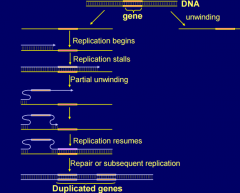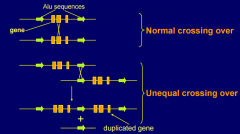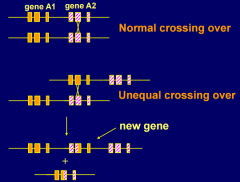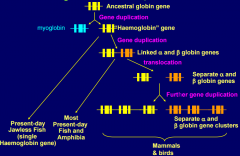![]()
![]()
![]()
Use LEFT and RIGHT arrow keys to navigate between flashcards;
Use UP and DOWN arrow keys to flip the card;
H to show hint;
A reads text to speech;
20 Cards in this Set
- Front
- Back
|
How many human genes have a directly equvalent orthologue in mice? |
- approximately 80% |
|
|
What causes the biggest difference between gene content of different vertebrate genomes? |
- changes in the number of members of genes within gene families e.g. olfactory receptors - 396 in human, 1035 in mouse |
|
|
How do new genes arise? |
- reverse transcr. mRNA (generate retrogenes) - exon shuffling - exons from 1 gene become inserted into or fused with another gene - de novo - mutation of non-coding DNA - Gene duplication |
|
|
What is Gene duplication |
- most new genes and new members of gene family arise through gene duplication - every gene is believed to undergo a duplication event once every 100 mln years |
|
|
How does gene duplication occur? |
- Replication slippage - unequal crossing over between repetitive sequences - unequal crossing over between duplicated genes - whole genome duplications |
|
|
What is replication slippage? |

|
|
|
What is unequal crossing over between repetitive sequences? |

- May occur where gene is flanked by two copies of a repetitive sequence (e.g. Alu), |
|
|
What is unequal crossing over between duplicated genes? |

- may occur where there is a cluster of two or more related genes (during meiosis) |
|
|
Give an example of a whole genome duplication: |
- Xenopus tropicalis - diploid genome - Xenopus laevis - tetraploid genome - may have undergone one or two rounds of gene duplication about 500 mln years ago |
|
|
What is the fate of duplicated genes? |
- nonfunctionalization - 1 copy becomes inactivated through mutation (pseudogene) - neofunctionalization - one copy acquires new function - subfunctionalization - one copy acquires a subdivision of function |
|
|
Give an example of neufunctionalization: |
- antifreeze glycoprotein gene in Antarctic fish encodes a glycoprotein with 41 copies of the motif Thr-Ala-Ala, evolved from a duplicate of the trypsinogen gene |
|
|
Neofunctionalization - scheme |

|
|
|
Give an example of subfinctionalisation |
- if gene is expressed in several tissues, each duplicate may become expressed in a subset of the tissue that the parent gene was expressed in - most vertebrates: single aromatase gene expressed in brain and ovary - fish - duplicate aromatase genes, one expressed in brain one expressed in ovary |
|
|
How did the hypothetical scheme for evolution of duplicated aromatase genes in fish? |
- The original gene had one sequence controlling expression in brain and another controlling expression in brain - in fish the ovary mutated one sequence and the brain - the other |
|
|
What is an example of gene family generated by gene duplication? |
- Haemoglobin - tetramer - different isoforms are used in different stages of development |
|
|
Evolution in the globin family: |

|
|
|
When do pseudogenes originate? |
- inactivating mutation occur in a newly duplicated genes - inactivating mutations occurn in an existing gene that has become surplus to requirement |
|
|
How many pseudogenes are there in humans? |
- 3230 known; 425 are from olfactory receptors |
|
|
Where do processed pseudogenes and retrogenes arise from? |
- reverse transcription of mRNA molecules - either become inactive processed pseudogene - or potentially active retrogene |
|
|
What are the differences between processed pseudogenes and pseudogenes> |
- processed are derived from mRNA -no introns, no promoter, polyA tail; - processed are distant from active related genes, normal genes may be in clusters with active genes - processed are flanked by direct repeats |

